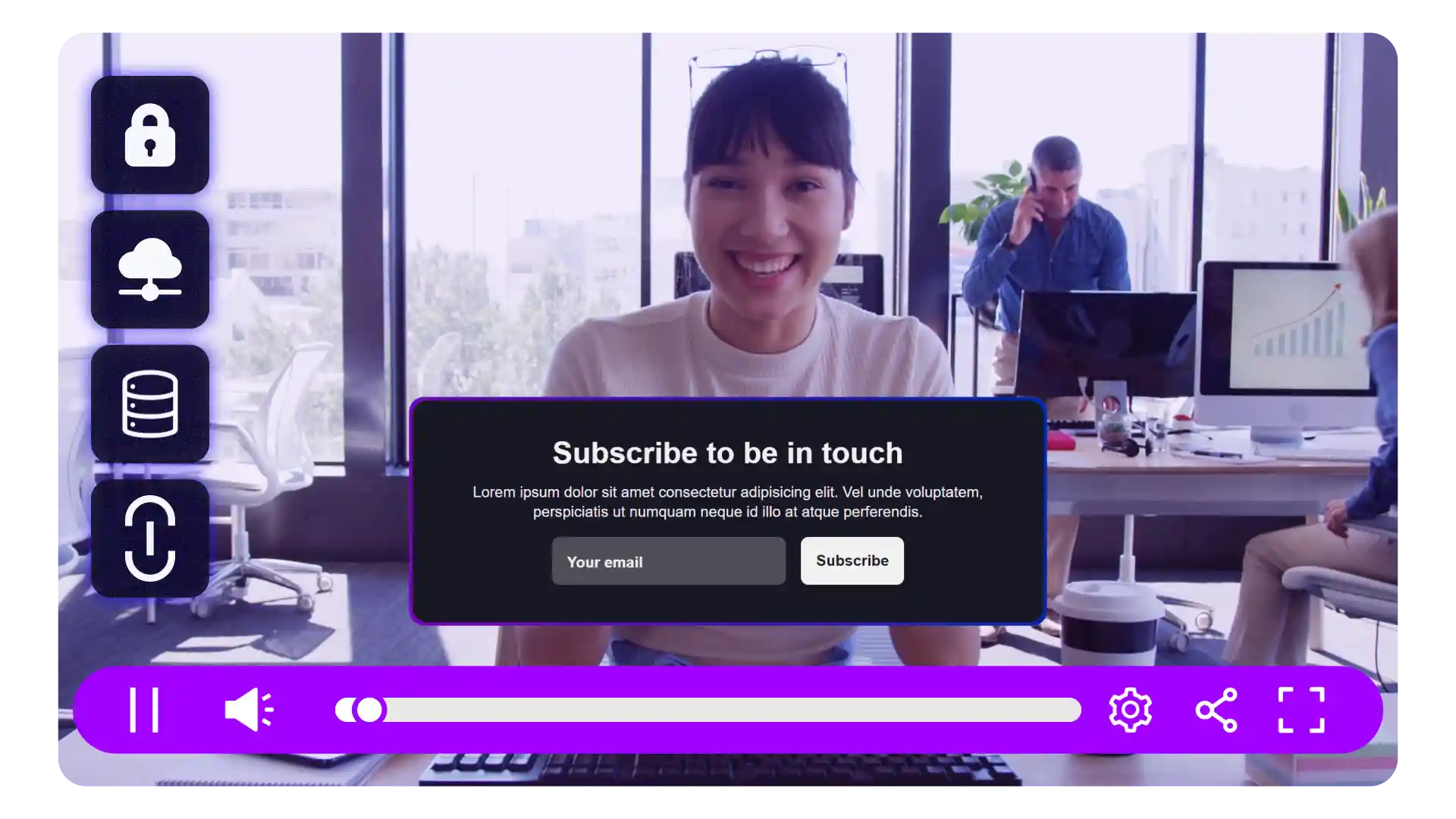Secure video streaming protects sensitive content from piracy, hacking, and unauthorised access, which is essential for professionals handling confidential or monetised media. From training materials to commercial broadcasts, using secure methods reduces risk and maintains control over distribution. This article outlines seven reliable security measures you can implement to safeguard your video streams and protect both your content and your viewers' data.
Is video streaming encrypted?
For most secure video streaming platforms, encryption is a core part of video streaming security. It ensures that your content can be delivered over the internet without exposing it to unauthorised access. Encryption works by converting video data into an unreadable format during transmission. Only authorised viewers with the correct decryption key can access the original stream.
Two of the most common encryption methods used are HTTPS and AES (Advanced Encryption Standard). HTTPS encrypts the connection between the viewer's browser and the server, protecting data in transit. AES adds another layer by scrambling the video stream itself, making it virtually impossible for intercepted files to be viewed.
Encryption is especially important when streaming content for internal training, paid access, or client-facing video portals. It's valuable for government agencies, law firms and any other industries where security and confidentiality is important. In short, if you're using video in any professional context, secure video encryption should be considered non-negotiable.

Top 7 security techniques for professional video streaming
If you use video for training, marketing or monetisation, securing that content is critical. From encryption to access controls, secure video streaming helps protect your assets and audience data. The methods below are widely used by professionals to prevent unauthorised access, piracy, and data breaches. They can be used individually or they can be combined for optimal protection.
1. AES encryption
AES (Advanced Encryption Standard) is one of the most trusted methods for protecting video content. It works by scrambling video data using a unique decryption key. Without this key, viewers cannot access the secure video stream even if they intercept the file.
This method is widely adopted by broadcasters and enterprises because it's both secure and simple to implement. Many secure video streaming platforms let you enable AES encryption with just a click, making it a practical first line of defence.
AES is also a core part of HLS (HTTP Live Streaming), where video segments are encrypted individually and delivered with secure keys to authorised viewers.
While AES alone is strong, it's most effective when combined with other security tools like HTTPS or domain restrictions.
2. HTTPS delivery
HTTPS (Hypertext Transfer Protocol Secure) ensures all data transferred between your video platform and the viewer's browser is encrypted. This shields content from interception during transmission, protecting your videos as well as any user information exchanged during playback.
It's particularly important on public or unsecured networks, such as those in cafés, schools, or airports, where "man-in-the-middle" attacks are more likely. In these cases, attackers might try to hijack streams or inject malicious content. HTTPS prevents this by wrapping all communication in a secure layer verified by digital certificates.
Most professional video hosting and streaming platforms now enforce HTTPS by default, which protects viewers and improves SEO rankings. For platforms that don't enforce it, enabling HTTPS should be a top priority before distributing any video content.
3. SSL/TLS encrypted paywalls
If you're monetising content, protecting payment data is just as important as securing the video stream itself. SSL (Secure Sockets Layer) and TLS (Transport Layer Security) are encryption protocols that safeguard sensitive customer information like credit card numbers.
A secure paywall built with SSL/TLS ensures transactions happen over encrypted connections; just like those used by banks. This ensures that buyers are protected and helps you stay compliant, avoiding liability in the event of a breach.
Look for paywalls that support multiple payment methods and currencies, and make sure SSL/TLS protection is built-in.
4. Password-protected video
Password protection offers a straightforward yet effective way to restrict video access to approved viewers. By assigning a password to specific videos, you create a basic authentication layer that keeps your content out of reach from unauthorised audiences.
This method is ideal for internal training videos, client previews, or early-stage content not ready for public release. It's quick to implement on most platforms and doesn't require any advanced setup.
However, passwords can be shared, so this method is best used in combination with other security features. For higher-risk content, consider rotating passwords regularly or pairing this option with IP restrictions or user-based access controls.
5. Geographical restrictions
Geographic restrictions (also known as geo-blocking) help control who can access your videos based on their physical location. This is particularly useful for licensing compliance, regional marketing strategies, or minimising piracy from high-risk areas.
By using IP-based whitelisting and blacklisting, you can allow or block access to your content in specific countries or regions. For example, if your content is licensed only for North America, geo-restrictions ensure viewers outside that zone cannot access it.
While not foolproof (as VPNs can sometimes bypass these restrictions), geo-restrictions remain a valuable tool in a multi-layered security setup.
6. Referrer restrictions
Referrer (or domain) restrictions allow you to specify exactly which websites are authorised to host or embed your video. This prevents your content from being copied and streamed on third-party sites without permission.
When a video is embedded on a webpage, the platform checks the page's domain against a list of allowed referrers. If the site isn't authorised, the video won't load, which protects your content from unauthorised distribution or piracy.
This is especially useful for exclusive or partner-only content, and it works well alongside geo-blocking and password protection to enforce tighter control.
7. Secure video delivery with CDN and data centres
A Content Delivery Network (CDN) is essential for delivering high-performance, secure video streaming at scale. When paired with secure data centres, CDNs can speed up delivery and enhance resilience, protecting your content against a wide range of threats.
CDNs distribute your video files across a global network of servers, reducing latency and minimising buffering. At the same time, they provide defence against Distributed Denial of Service (DDoS) attacks and ensure uptime through redundancy and load balancing.
Using a secure CDN-backed platform means your content is stored, encrypted, and delivered with built-in protection, keeping your streaming environment fast, reliable, and secure.

Best practices for secure video streaming
To strengthen your streaming security, it's best to combine platform features with smart operational habits. Here are some practical best practices to follow:
- Layer your defences: Don't rely on a single method. Use a combination of encryption, password protection, geo-restrictions, and referrer restrictions to cover different risk points.
- Update credentials regularly: Rotate passwords and tokens periodically, especially for sensitive or internal content, to reduce the risk of leaked access.
- Monitor for leaks: Run regular checks (e.g., Google searches for your video titles with keywords such as “password”) to detect any publicly shared credentials.
- Use multi-factor authentication (MFA): Enable MFA on all streaming-related accounts, including your video hosting platform, encoder tools, and CMS logins.
- Review access logs: Many platforms offer analytics and access logs. Use these to spot unusual behaviour or access patterns.
Secure video streaming involves staying alert and having protocols in place to respond quickly to potential threats.
Final thoughts about securing your video streaming strategy
As video becomes more central to business operations, protecting your content is essential. From encryption and domain restrictions to CDNs and secure paywalls, each layer of defence helps ensure your content reaches the right audience without compromise.
Professionals who take security seriously protect their intellectual property, their brand reputation, and user trust. If you're looking for a video hosting platform that offers enterprise-grade security alongside interactive and analytics capabilities, explore Cinema8 and see how we can support your secure streaming needs.
